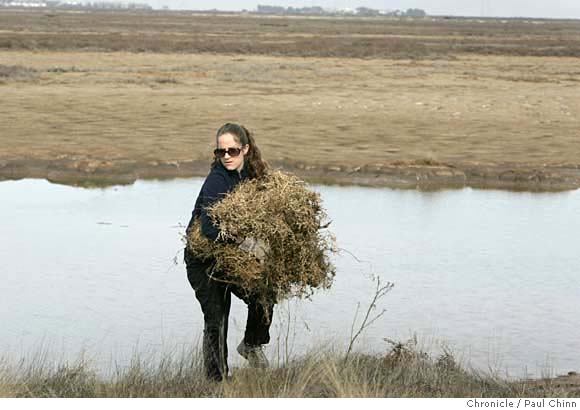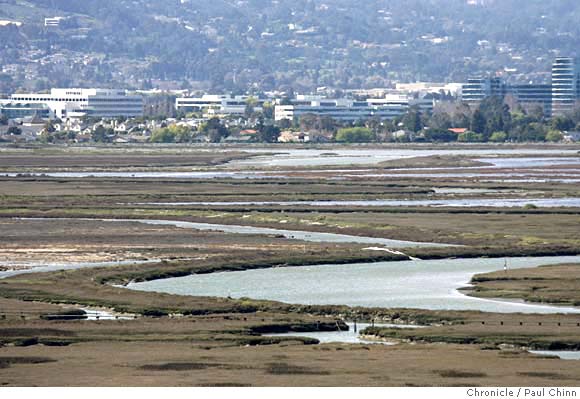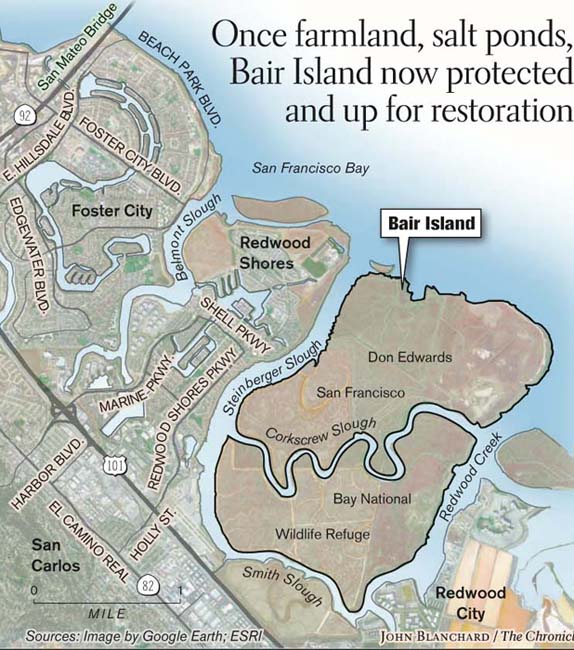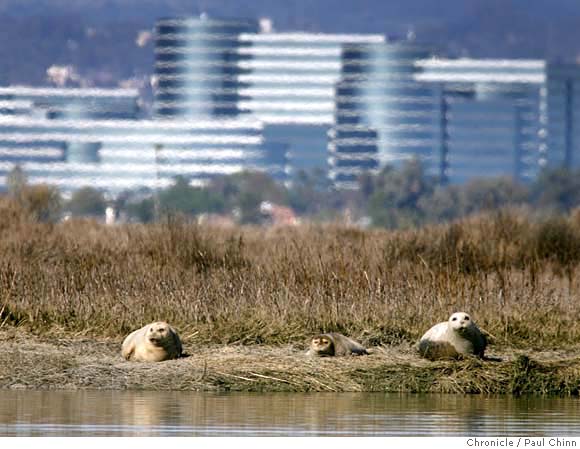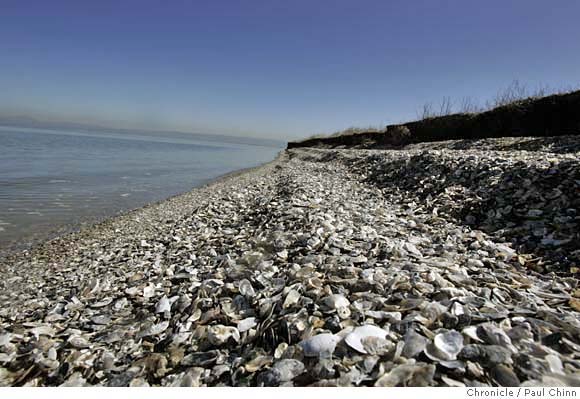Overview
Bair Island Restoration Project, San Francisco Bay, California.
Bair Island is located in the southern part of San Francisco Bay and is now owned by the State of California as the Bair Island State Ecological Reserve. Donated by the Peninsula Open Space Trust after they purchased it from a company whose housing development plans fell through, it was passed on to and is now managed by Don Edwards San Francisco Bay National Wildlife Refuge in Redwood City.
A geographical aspect of San Francisco Bay-Delta Estuary, Bair Island is considered an ecological treasure that supports enormous biodiversity and consists of three islands; Inner, Middle, and Outer Bair. However, prior to being considered ecologically valuable, Bair Island resources had been utilized for a economical purpose through-out the last century.
Between 1946 and 1952, the Leslie Salt Company partitioned Bair Island with dirt levees for use as salt-making evaporation ponds, creating three islands separated by Smith and Corkscrew sloughs. After 1965, these salt ponds on Bair Island were abandoned by the Leslie Salt Company, and were soon drained. However, the land has tolerated human encroachment since the early 1800’s when farmers first converted the salt-marsh to agricultural land.
Until the 1940’s, Bair Island was an area known for its unspoiled tidal salt-marsh, tidal sloughs, and mudflats. Although it is hard to know the ecological biodiversity of the area during this time and before impairment, Bair Island now provides critical habitat for a variety of species. The reserve is home to approximately 120 fish species, 255 bird species, 81 mammal species, 30 reptile species, and 14 amphibian species – all of which rely on the wetlands for food, shelter, and breeding habitat. These species include the endangered California clapper rail (Rallus longirostris obsoletus), the salt marsh harvest mouse (Reithrodontymys raviventris), the Western snowy plover (Charadrius alexandrinus nivosus), California least tern (Sterna antillarum browni), and the California brown pelican (Pelecanus occidentalis californicus). Bair Island is also an important stop for birds on the pacific flyway. Besides its ecological importance, it stands as economically viable tourist area. As a result, the U.S. Fish and Wildlife will be supporting and overseeing the Bair Island Restoration Project.
The restoration of Bair Island marsh complex will return 1, 400 acres of diked marsh to tidal marsh primarily by breaching the perimeter levees to allow tidal action via surrounding slough channels. Excavations through the internal levees will reestablish historical channels to facilitate circulation and drainage. Some levees will remain in place to provide marsh-plain habitat and to prevent shoreline erosion.
It is hoped that the restoration project will improve water quality, expand and enhance wildlife habitat and reduce mosquito (Aedes squamiger) breeding conditions by restoring tidal flow. The restoration will also give public access to the Bay shoreline and provide opportunities for public involvement and stewardship.
The goals of the restoration project are:
– restore a significant wetland complex to high quality tidal salt marsh
– maximize tidal function and habitat values in a short period of time
– enhance habitat for endangered species and native Bay wildlife
– provide opportunities for the public to learn about the Island’s unique resources by offering an on-going Community-Based Restoration programs at Inner and Middle Bair Island
Quick Facts
Project Location:
Bair Island, San Francisco Bay, 37.5209209, -122.22568030000002
Geographic Region:
North America, Pacific Ocean
Country or Territory:
United States of America
Biome:
Coastal/Marine
Ecosystem:
Estuaries, Marshes & Mangroves
Area being restored:
14,000 acres
Organization Type:
Governmental Body
Location
Project Stage:
Planning / Design
Start Date:
2007-04-02
End Date:
2007-04-02
Primary Causes of Degradation
Agriculture & LivestockDegradation Description
Urban encroachment
Conversion from marsh to farmland
Dirt levees artificially put in place to reduce salt water flow and therefore creation of salt-making evaporation ponds.
Reference Ecosystem Description
Until the 1940’s, Bair Island was an area of unspoiled tidal salt marsh consisting of several thousand acres of marsh, tidal sloughs and mudflats.
Project Goals
Removing levees and allowing tidal action will eliminate prime mosquito breeding habitat and reduce the threat of mosquito-borne infection for the community. Provide habitat for endangered species, California clapper rail (Rallus longirostris obsoletus), the salt marsh harvest mouse (Reithrodontymys raviventris), the Western snowy plover (Charadrius alexandrinus nivosus), California least tern (Sterna antillarum browni), and the California brown pelican (Pelecanus occidentalis californicus). Public access will be maintained by a 2.7-mile levee trail on Inner Bair Island for pedestrians enhancing educational opportunities. Community-based volunteer programs will assist with restoration of the native marsh vegetation and weed removal, providing opportunities for adults and children to participate in the restoration process at Bair Island.
The goals of the restoration project are:
– restore a significant wetland complex to high quality tidal salt marsh
– maximize tidal function and habitat values in a short period of time
– enhance habitat for endangered species and native Bay wildlife
– provide opportunities for the public to learn about the Island’s unique resources by offering an on-going Community-Based Restoration programs at Inner and Middle Bair Island
Monitoring
The project does not have a monitoring plan.
Stakeholders
Portions of Bair Island are owned by the State of California as the Bair Island State Ecological Reserve (California Department of Fish and Game oversees) within an agreement to manage the state’s lands as part of the Refuge (Don Edwards San Francisco Bay National Wildlife Refuge).
Ecological Outcomes Achieved
Socio-Economic & Community Outcomes Achieved
Sources and Amounts of Funding
~10 million USD Roughly $10 million has been allocated towards the projects.
The refuge has secured $1.2 million to have engineering drawings drafted.
This project is supported by; The National Partnership between Restore America’s Estuaries; the NOAA Community-Based Restoration Program; Federal Government; Pacific Gas and Electric; Oracle; U.S. Fish and Wildlife Services (involved in planning).


